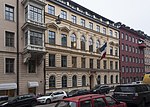Royal College of Music, Stockholm
1771 establishments in Sweden1771 in SwedenEurope university stubsHigher education in StockholmMusic organization stubs ... and 4 more
Music schools in SwedenRoyal College of Music, StockholmSwedish school stubsUniversity colleges in Sweden

The Royal College of Music, Stockholm (Swedish: Kungliga Musikhögskolan i Stockholm) is the oldest institution of higher education in music in Sweden, founded in 1771 as the conservatory of the Royal Swedish Academy of Music. The institution was made independent of the Academy in 1971, and is now a public authority directly under the Ministry of Education and Research. Vice-Chancellor from June 2019 is Helena Wessman, former general manager of Berwaldhallen.
Excerpt from the Wikipedia article Royal College of Music, Stockholm (License: CC BY-SA 3.0, Authors, Images).Royal College of Music, Stockholm
Lidingövägen, Stockholm Ladugårdsgärdet (Norra Innerstaden)
Geographical coordinates (GPS) Address Nearby Places Show on map
Geographical coordinates (GPS)
| Latitude | Longitude |
|---|---|
| N 59.343888888889 ° | E 18.081111111111 ° |
Address
Kungliga Musikhögskolan
Lidingövägen
114 33 Stockholm, Ladugårdsgärdet (Norra Innerstaden)
Sweden
Open on Google Maps











